 Image search results - "omatsu" Image search results - "omatsu" |

Dai-hiwatari Festival, Mt. TakaoMore pictures here
|
|

Held on Dec. 2-3 by Chichibu Shrine, Chichibu Yomatsuri is one of Japan's Big Three Hikiyama Float Festivals. Ornate floats are pulled along the city's main streets until they reach a large plaza at night where they are lit with lanterns. Fireworks then serve as the climax. Photo: Seibu Chichibu Station
|
|

In front of Seibu Chichibu Station
|
|
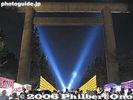
Yasukuni Shrine's main torii during Mitama Matsuri
|
|

Main street crowd
|
|

Floats parked along the main drag.
|
|

Ornate float is pulled along the streets toward Chichibu Shrine.
|
|
|
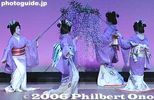
1. Fuji Murasaki (Purple Wisteria) by Kagurazaka geisha
|
|
|

Stage at Chichibu Shrine
|
|

Chichibu Shrine
|
|
|
|

Chichibu Shrine offertory bin
|
|

Stage performance at Chichibu Shrine
|
|
|

Many women drummers also perform. Shinjuku Eisa Matsuri, Tokyo
|
|

Float at Chichibu Shrine
|
|
|

Priests splash cold water over themselves at the Nose Myokenzan Betsuin in Sumida-ku, Tokyo
|
|

Float at Chichibu Shrine
|
|
|
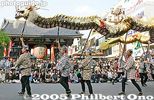
According to legend, three days after the golden Kannon statue was found, a golden dragon descended from heaven and danced. The mountain name of the temple is Kinryu-zan, meaning Golden Dragon Mountain. (Most temples have a mountain name.)
|
|

Yabusame archer
|
|

Main drag
|
|

Mini octopus
|
|

Storehouse for a float
|
|

Local fire station designed like a float.
|
|
|
|

How to turn the float.
|
|

Children's kabuki
|
|
|
|
|
|

A float proceeds to the Otabisho plaza.
|
|

A float proceeds to the Otabisho plaza.
|
|

Taiko drum performance at the Otabisho.
|
|

A float climbs up the Dangozaka slope before entering the Otabisho.
|
|

団子坂
|
|
|
|
|
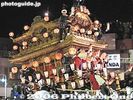
With great fanfare, the floats are pulled up the slope.
|
|
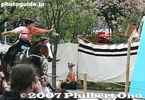
The crowd favorite was this high school girl. See the arrow pierce the wooden target.
|
|
|
|
|
|
|

Setsubun bean throwing at Takahata Fudoson temple, Hino, Tokyo
|
|
|
|

In the Otabisho, a large plaza.
|
|
|
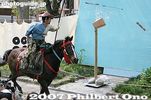
The wooden target boards have an envelope of confetti stuck on the back so it explodes when the target breaks apart.
|
|

The festival climaxes with fireworks.
|
|

The warrior monk costume is interesting. The collar makes them look bigger and more fearsome. 僧兵行列
|
|
|
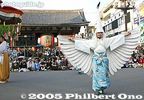
White Heron Dance
|
|
|
|

Chichibu Night Festival climax
|
|
|

Tekomai geisha from Tomioka Hachimangu Shrine walk toward the stage.
|
|

Koenji Awa Odori, Aoi Shin-ren 葵新連
|
|

Oiran Dochu Procession
|
|
|
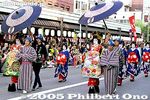
Oiran Dochu Procession. This picture was taken in the 1990s when they had two oiran in the festival. Now they have only one. 花の吉原おいらん道中
|
|
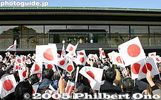
10:20 am: The Emperor and Empress appear right on time on his birthday. As soon as they appeared, people waved paper flags and cheered "banzai!" Also see the video at YouTube.It was an amazing spectacle. I always saw it on TV, but this was the first time I saw it in person. I wish I went when Emperor Hirohito was still living.
From left to right is Princess Nori, the Crown Prince, the Emperor, the Empress, and Prince and Princess Akishino. Crown Princess Masako did not appear due to illness.
I also once used this shot for the cover photo on my home page.
|
|

Hiwatari fire-crossing festival, Mt. Takao, Tokyo
|
|
|

Koenji Awa Odori
|
|
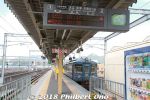
At JR Fukuchiyama Station, Kyoto Tango Railways operates a special tourist train named "Aomatsu" to Amanohashidate. It's just one train car.It's a cafe train that serves drinks and light meals.
JR Fukuchiyama Station is a major gateway to northern Kyoto Prefecture because it is a terminal station for Kyoto Tango Railway, the dominant train network in this area.
|
|
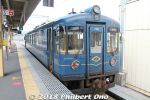
The Aomatsu train runs once every morning (10:17 am) and afternoon (3:17 pm) from Fukuchiyama Station to Amanohashidate Station and requires no reservations or extra train fare.
|
|
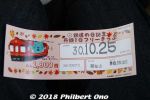
This Kyoto Tango Railways one-day train pass is a good deal.
|
|
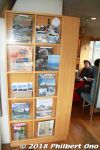
Enter the Aomatsu train and see this rack of tourist pamphlets.
|
|
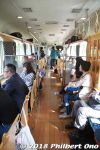
Aomatsu is special because the interior is wooden and it has a variety of seating (train fare is the same for all seats).It's a cafe train and you can order drinks (including alcohol) and light meals. No reservations required, and it's all non-reserved. Train fare is the same as regular trains.
|
|
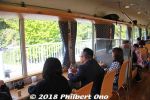
Window seats at the counter.
|
|

Counter seat with a knob to hold on to.
|
|
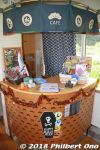
There's a staffed bar where you can order drinks and food.
|
|
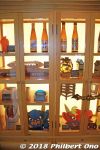
Wooden showcase.
|
|
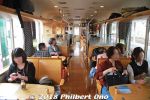
Cafe-type seats (wooden) with a table.
|
|
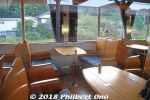
Cafe-type seats (wooden) with a table.
|
|
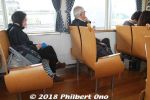
Toward the front of the train are regular seats.
|
|
|
|

Bathroom sink.
|
|
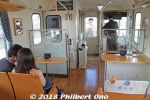
Front of the Aomatsu train.The Aomatsu train runs only twice a day from Fukuchiyama to Amanohashidate taking about an hour. Love this train.
https://trains.willer.co.jp/matsu/aomatsu.html
|
|
|
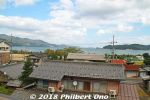
View from the Aomatsu train.Kyoto Tango Railway has another cafe train named "Akamatsu" that runs twice a day (except on Tue. and Wed.) between Nishi-Maizuru and Amanohashidate. But this train requires reservations.
https://trains.willer.co.jp/matsu/akamatsu.html
There's also the "Kuromatsu" restaurant train that runs on Fri., Sat., Sun., and national holidays. You can order a full dinner or confections or sake. The train fare includes the meal or drinks and obviously will be much more expensive than regular train fare.
https://trains.willer.co.jp/matsu/
|
|
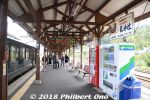
Amanohashidate Station
|
|
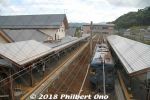
Amanohashidate Station
|
|

Inside Amanohashidate Station. Nice station with luggage lockers and English-speaking tourist information desk.
|
|

Inside Amanohashidate Station.
|
|
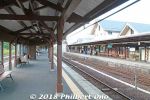
Amanohashidate Station plaform.
|
|
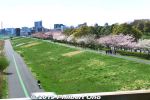
Komatsugawa Cherry Blossoms (Komatsugawa Senbon-zakura) are along the west side of Arakawa River.
|
|
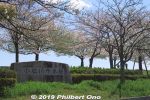
They line the pedestrian and cycling path on the riverbank. Very nice. Near Higashi-Ojima Station on the Toei Shinjuku Line.
|
|
|
|
|
|
|
|
|
|
|
|
|
|
|
|
|
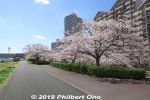
Cycling here when the cherry blossoms are in bloom is very pleasant.
|
|
|
|
|
|
|
|
|
|
|
|
|
|
|
|
|
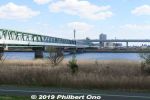
Toei Shinjuku subway line tracks over Arakawa River. The tower in the background is Funabori Tower.
|
|
|
|
|
|
|
|
|
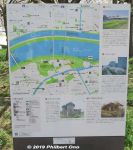
Map of the area.
|
|
|
|
|
|
|
|
|
|
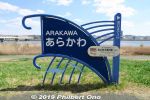
Arakawa River sign.
|
|
|
|
|
|
|
|
|
|
|
|
|

Omi-Maiko Station on JR Kosei Line. It makes it easy for people in Kyoto to visit Omi-Maiko. MAPSign says "Welcome to Omi-Maiko." Omi-Maiko was in the former town of Shiga-cho that merged into Otsu.
|
|

Go left or right...Disobey the sign and go right to visit the main beach.
|
|

Go left to visit the hotel
|
|

Or go right to see the best beaches...
|
|

White sands at Omi-Maiko, Lake Biwa.
|
|
|
|
|
|
|

Clear waters and beautiful Lake Biwa beach at Omi-Maiko
|
|

Omi-Maiko
|
|

Green pine and white sand of Omi-Maiko, Lake Biwa.
|
|
|

Marker for OmatsuOmatsu is the old name for Omi-Maiko.
|
|
|
|
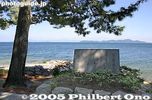
Monument for Lake Biwa Rowing Song (Biwako Shuko no Uta).In June 1917, a song called Biwako Shuko no Uta (Lake Biwa Rowing Song) was composed by college student Taro Oguchi during a boat rowing trip around Lake Biwa. He was a member of the rowing club at Dai-san High School (now Kyoto University). He composed it in Imazu, Shiga Prefecture during the second night of the trip.
The song is about the boys rowing around Lake Biwa while mentioning famous places like Otsu (the starting point), Omi-Maiko (Omatsu), Imazu, Chikubushima, Nagahama, and Chomeiji.
Another boat mate matched Oguchi's lyrics to the melody based on the old song called Water Lilies as modified by a young Chiaki Yoshida. It soon became a popular dormitory song.
|
|
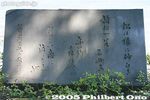
Monument for Lake Biwa Rowing Song (Biwako Shuko no Uta)The song became a national hit in 1971 when singer Tokiko Kato recorded it. Numerous famous Japanese singers and groups have since released cover versions of the song. The town of Imazu even holds an annual song contest in June when choir groups from around Japan sing the song in a competition. The town even has a museum dedicated to the song.
One of the verses mentions Omatsu (now called Omi-Maiko). This monument commemorates the song and that verse.
|
|

Manyoshu Monument
|
|

Monument for Biwako Hakkei. "Cool Breeze on White Sands of Omatsu" is one of the Eight Views of Lake Biwa as selected in 1949.
|
|
|
|
|

Omi-Maiko Beach Management Office
|
|

Goddess for lake safety
|
|

Attached lake behind the beach
|
|
|
|
|
|
|
|
|
|
|

Parking lot entrance
|
|

A little south of Omi-Maiko. Bicycled from Omi-Maiko and went south.
|
|
|
|
|
|
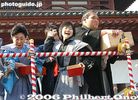
Setsubun bean throwing at Zojoji Temple in Tokyo with Tamao-chan, Ai-chan, and TochiazumaAi-chan was really cute and seemed to be having a great time throwing the beans. Nakamura Tamao (actress), Fukuhara Ai (table tennis player) and Ozeki Tochiazuma (sumo wrestler)
|
|
|
|